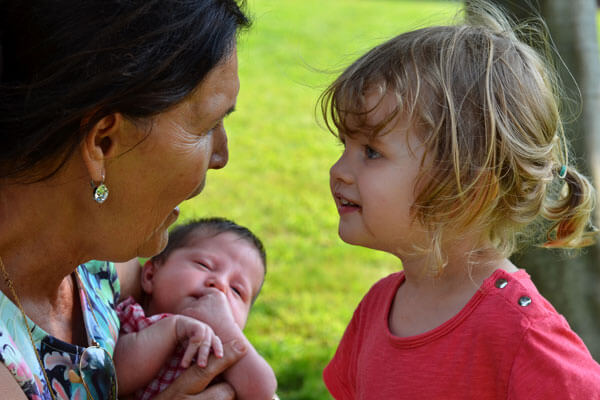Physically active play – outdoor and indoor
Healthy habits start earlier than you think. Begin introducing your baby to outdoor time right away. There is no specific temperature that is too high or too cold for a baby to go outdoors. Physical outdoor and indoor activity is part of healthy active living.
Encourage access to active play in nature, outdoors, at home, school, child care and in the community. Playing outside gives your child the freedom to explore, to get dirty and to tumble. When outside he moves more and he has the chance to experiment. He learns to take risks and manage risks.
Being physically active is fun. Being physically active helps children:
- Build strong muscles and bones.
- Develop and grow in a healthy way (e.g., good physical and mental health).
- Develop self-esteem and respect for others.
While being physically active, your child learns many skills such as:
- Eye-hand coordination (e.g., climbing a play structure).
- Large muscle skills (e.g., running).
- Small muscle skills (e.g., picking up a small ball or picking a flower).
Children aged 2 to 5 years should engage in physically active outdoor and indoor play for at least three hours every day. The Canadian Physical Activity Guidelines suggest a progression toward at least 60 minutes of energetic play per day by 5 years of age.
Physically active play can happen any time during the day as part of play, games, transportation (e.g., walking), or a family activity such as swimming or skating. Your child learns by looking at you and by following your example. Remember you are your child greatest educator and role model. If you are active, she will also be active.
Some examples of how you can include physical active play:
- Put on some music and dance or move around.
- Create an obstacle course with obstacles to crawl under, climb over and run/walk around.
- Go for a walk around your neighbourhood (this helps your child become familiar with nearby parks and schools).
- Roll, throw, catch, and kick balls and other objects of different sizes.
- Go skating or swimming.
- Go to the park, playground or walk in the forest.
So, let your child play! Let your child play outside in various weather conditions such as snow and rain.
Go play with your child! There is nothing in the world your child would rather do than play with you!
How can I play with my child?

Different adults play differently with their children. Parents, family members, and other caregivers all provide different opportunities for your child to play, explore, and learn. You may prefer to play active games or to take your child for a walk to explore outside so he can touch and smell the natural materials. Your partner may prefer to play games with rules. You may like to read to your child while your partner tells stories and acts them out. That is okay. Children need more than one adult in their lives who may all play differently.
Encourage other family members and care providers to play with your child. Just set some clear safety rules for everyone. It also helps, if everyone knows the developmental stage of your child and can play with him according to his age and ability (check out the Looksee Checklist by ndds).
Tips that help you play with your child:
- Engage in your child’s play by listening, observing, communicating (label, ask questions, explain, praise your child’s accomplishment).
- Try to respond when your child initiates play.
- Actively listen to your child while he is playing.
- Respect your child’s interests.
- Get to your child’s level (sit with him on the floor).
- Observe what your child is doing before joining his play. This will allow you to engage in his play by following his lead. Talk with him in the language you are most comfortable with. Below are a few examples to develop your child’s critical thinking process.
- “I noticed that you built a garage for your cars. Tell me more about it.”
- “Where do I find the plates for dinner?”
- “I see that you wrote the names of different foods on your menu. You are a writer!”
- “Who takes care of the pets when your store is closed?”
- “I wonder what is going to happen when you place this big block on top of your tower.”
- Decide with your child what should be in his play area. For example:
- Materials that encourage pretend play, such as a variety of items for costumes, stuffed animals and dolls, toy cash register, a variety of toy vehicles, empty food boxes and add plastic jars, play money, etc.
- Paper, pencils and crayons to help your child develop communication skills.
- A variety of containers and measuring tools, such as rulers, measuring tapes and simple timers to stimulate his interest in mathematical and scientific concepts.
- Read stories with your child, then re-tell them or act them out.
- Use music to move and dance with your child, or to help him become quiet and calm.
- Respect your child’s attention limit according to his age and his development.
- Know when it is time to stop.
- Take your child out for a walk around your neighbourhood or a hike through the park.
- Talk about the things you have seen together, e.g.:
- “I noticed the birds have built a nest in that tree. I wonder what is inside.”
- Pretend play what you have done together (e.g., going to the grocery store).
- Develop a routine so your child has times for active play and times for quiet play.
- Let your child help you with simple chores and talk about them. For example when grocery shopping, let your child pick fruits and vegetables and place them in the bag. To enhance his mathematic skills you can count them together.
- Plan, cook, and prepare food with your child. Let your child try simple tasks in the kitchen (e.g. add ingredients to a bowl).
Provide opportunities for your child to use all his developing skills:
- Large muscle skills – e.g., running, climbing, pulling, pushing
- Small muscle skills – e.g., drawing, painting, catching
- Social skills – e.g., turn-taking, sharing, cooperating, negotiating, initiating interactions
- Emotional skills – e.g., showing feelings, caring
- Language skills – e.g., listening, talking, asking using words, rhyming, singing, telling stories, reading recipes
- Thinking skills – e.g., exploring, investigating, planning, matching, problem-solving.
